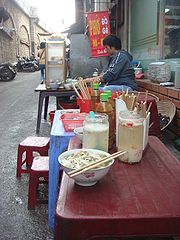Phở is a Vietnamese thinly sliced meat and noodle soup dish. The soup includes noodles made from rice and is often served with basil, lime, sprouts and peppers that are added to the soup by the customer (as well as any condiments desired). The most common variety includes thinly sliced beef brisket or flank.
Phở is served in a bowl with white rice noodles in clear beef broth, with thin cuts of beef (steak, fatty flank, lean flank, brisket). Variations featuring tendon, tripe, meatballs, chicken leg, chicken breast, or other chicken organs. ‘With the lot’ (made with chicken broth and all or most of the shop’s chicken and cattle offerings, including chicken hearts and livers and beef tripe and tendons) is known as ‘Phở đặc biệt’ (specialty phở) There are also various vegetarian varieties of phở.
Broth
The broth is generally made by simmering beef (and sometimes chicken) bones, oxtails, flank steak, charred onion, and spices, taking several hours to prepare. Seasonings include Saigon cinnamon, star anise, charred ginger, and cloves
Noodles
The noodles, called bánh phở in Vietnamese, are traditionally cut from wide sheets of fresh rice noodles similar to Chinese Shahe fen, although dried noodles (also called “rice sticks”) may also be used. Fresh noodles have a chewy, al dente texture, though they are more expensive and highly perishable. Dried pho is much softer and more affordable. Pho noodles should not be confused with clear noodles.
Garnishes
The dish is garnished with ingredients such as green onions, white onions, coriander leaves (cilantro), ngò gai (culantro, or long coriander), Thai basil, fresh Thai chili peppers, lemon or lime wedges, and bean sprouts.
Origins and regional differences
Because not much was written about the origin of phở until recently, its beginnings are a bit murky and mostly culled from oral histories. Still, the consensus among academics, diners and restaurateurs is that it originated about a century ago in northern Vietnam. It was originally sold by venders from large boxes, until the first phở restaurant was opened in the 1920s in Hanoi.

Phở gà at a typical phở street stall in Hanoi. Note the lack of side garnishes, typical of Northern Vietnamese-style phở.
While a distinctly Vietnamese dish, phở has French and Chinese influences. The origin of the word was one subject in a seminar on phở held in Hanoi in 2003. One theory advanced at the seminar is that the name comes from the French feu (fire), as in the dish pot-au-feu, which like pho uses the French method of adding charred onion to the broth for color and flavor, one of the techniques which distinguishes pho from other Asian noodle soups. Some believe the origin of the word to be the Chinese fen. In addition to rice noodles, multiple spices (such as star anise and cinnamon) are staples of Chinese cuisine (although the cinnamon used in phở, Saigon Cinnamon, is not a true cinnamon and is a local ingredient).
The variations in meat, broth and additional garnishes such as lime, bean sprouts, ngo gai (thorny cilantro), hung que (Thai/Asian basil), and tuong (bean sauce/hoisin sauce) appear to be innovations introduced in the south.
The specific place of origin appears to be southwest of Hanoi in Nam Dinh province, then a substantial textile market, where cooks sought to please both Vietnamese (local rice noodles – originally of Chinese origin) and French tastes (cattle before the French arrival being beasts of burden, not sources of beef).
Phở did not become popular in South Vietnam until 1954.
Cultural practices
Phở can be eaten for breakfast, lunch or dinner. The noodles are usually picked up with chopsticks and placed onto a soup spoon. The spoon is then dunked into the broth and topped with meat/condiments and eaten. Vietnamese phở restaurants usually retain the cultural practice of not delivering the bill to a customer’s table, since it is considered rude—in the Vietnamese culture, it is seen as a way of trying to rush the customer out the door.
Most tables usually have a numbering system and have chopsticks, spoons, serviettes and condiment dispensers. Hot sauce, usually either an XO sauce or sate chili sauce, and hoisin sauce are also available for those that like to dip their meat in them or add them to the soup.
Styles of phở
The most common variety of phở is a beef phở, called phở bò.
Another variation of phở uses egg noodles instead of rice noodles, which was based in Northern Vietnam. There are also Korean, Thai, and Lao variants of phở. Lao phở (feu) is usually topped with fried garlic. Another style of phở which is rare even among Vietnamese is phở tái lăn (phở with medium-cooked beef). Other cultures, such as the Chinese and Korean cultures, have adapted phở and provide a larger amount of onions as a side that is usually mixed with Sriracha sauce and Hoisin sauce.
Adapting to local tastes and diets, some Vietnamese restaurants in the United States offer chicken-based phở, called phở gà, or phở without visible pieces of meat (called phở rau), or vegetarian phở (called phở chay). Phở rau (rau literally meaning “leafy greens,” but implying vegetables) may use a meat-based broth, while phở chay (literally “Buddhist vegetarian phở”) features a non-meat broth. The time it takes to make the non-meat-based broth is much shorter and less tedious but has a different and lighter broth taste compared to the traditional beef noodle soup. Seafood-based phở is also commonly available




